Livestock General Information
Sheep
This article covers general information regarding sheep.
Quick Scroll
Introduction and Sheep Traits
Sheep are highly adaptable ruminants. They can make use of rough, arid lands that would not support other livestock such as cattle or swine. The adaptability and ideal environment for a sheep varies by breed. Different breeds are adapted to different temperatures, weather, and insects.
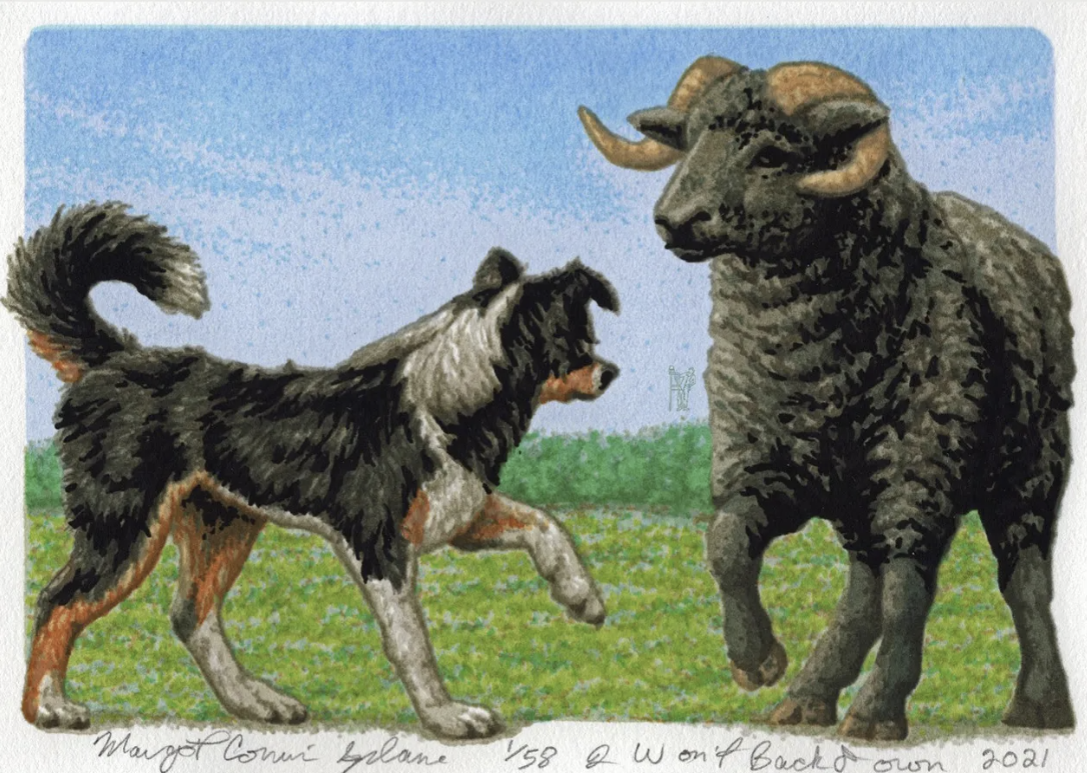
Cormier Splane, Margo. I Won't Back Down. 2021 (Link)
Sheep are unique in their ability to produce various commodities. Sheep can produce fiber, meat, and dairy products. This makes sheep an incredibly versatile species, however it also makes them hard to develop due to the need to balance the factors below.
Adaptability
Sheep must be able to produce in the environment they are raised in. Fine and medium wool breeds are the most adaptable, with meat breeds being more suited to farm environments with higher levels of input.
Prolificacy
Prolificacy refers to a sheep’s ability to produce and raise offspring. The number of lambs a ewe produces per lambing measures their prolificacy. Dry or barren ewes should be culled. Not all environments promote prolificacy. Fleece weight and prolificacy are negatively correlated; As more lambs are produced per ewe, the quality and quantity of the fleece is negatively impacted.
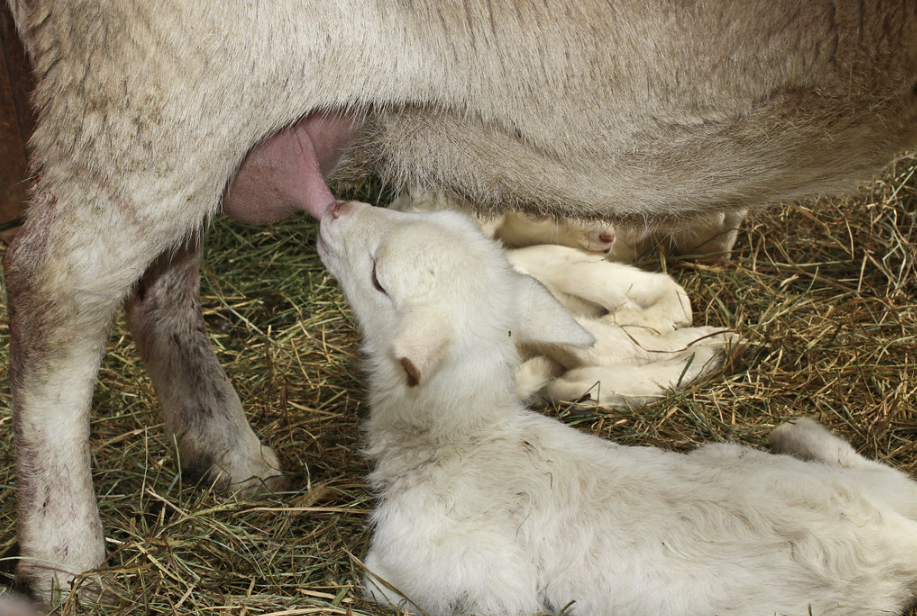
Susan S. Lazy Nurser. 2009 (Link)
Although prolificacy is desired, ewes that produce too many lambs may be undesirable. As the number of lambs per ewe increases, competition between lambs also increases, making it difficult for each lamb to receive the amount of support needed to survive. Quantity and quality of lambs must be balanced to be productive. The below factors are all second in importance to adaptability and prolificacy. Sheep should be stable in the above traits before developing those below.
The below factors are all second in importance to adaptability and prolificacy. Sheep should be stable in the above traits before developing those below.
Growth Rate
Growth rate refers to how fast an animal gains weight or matures over a period of time. Growth rate in sheep is measured by comparing a lamb’s weight at weaning to that of a post-weaning feeding period. Faster growing lambs can be marketed at a younger age than slow growing lambs. Lambs with higher rates of gain undergo a shorter feeding period, have improved feed efficiency, and a smaller risk of death.
Carcass Merit
Carcass merit refers to the value of a dead animal’s body, usually in meat producing animals. Carcass merit is difficult to measure in a live animal. Rate of gain and fatness is positively correlated. One can get an idea of an animal’s carcass merit through its rate of gain, or through central ram testing and testing programs. A lean, muscular carcass is preferred in sheep.
Fleece Traits
Fleece refers to the wool of a sheep. The sheep’s grease fleece weight, clean fleece weight, staple length, and grade (fineness or diameter) are the most important factors of a sheep’s fleece. These traits are highly heritable, meaning they are passed down through a sheep’s genetics. This means that proper selection is important when breeding for valuable fleece. Fleece traits are only relevant to wool-centric breeds that specialize in fiber production.

Oklahoma State University (Link)
One factor of a fleece’s value is its grade. Fiber grade is determined by the diameter of fleece stands, also referred to as its fineness. Long, fine fibers are optimal, as these are easier to turn into clothing and produce softer, more comfortable products. Fineness and length are difficult to balance, however, as longer strands are typically coarser.
Once wool is sheared from the sheep, it is sold by the pound. This means that sheep with heavier wool yield more profit. Producers can estimate their profits by estimating the amount of clean fleece a sheep will produce. To do this, one must take the grease fleece of a sheep and multiply it by its washing yield. Washing yield is expressed as a percentage and is determined by comparing the weight of a fleece right after it is shorn to the weight after it is washed. Grease fleece refers to the wool’s state directly after it is shorn. Grease fleece is heavier, as it contains contaminants such as dirt, oil, and plant matter.
Clean Fleece Yield (lb.) = Grease Fleece Yield (lb.) x Washing Yield (%)
Milk Production
Sheep are not commonly bred for milk production. The amount of milk a sheep produces is difficult to quantify. It is usually measured by the rearing of a lamb.
Types of Sheep Operations
Sheep can be raised in 4 main systems: Range flocks, farm flocks, purebred flocks, or feedlots. Dairy flocks may also be considered a separate system but are not common in the US.
Range Flocks
Range flocks are usually run by herders on large expanses of public lands. These flocks do not require much management or input. Range flocks are primarily found in the Western and Southern states, especially in poorer environments like the mountainous regions of New Mexico and Texas. Sheep on ranges must be hardy and durable, with good flocking instincts and an ability to make use of poorer vegetation. Flocks are typically comprised of 1,000 ewes or more. Wool-type sheep are the most common in range flocks. These flocks are typically the sole source of income for their managers. Offspring of range flocks may be retained, sold directly to processing plants, or sold to feedlots for finishing.
Farm Flocks
In recent years, farm flocks have risen in popularity. Flocks are typically much smaller than range flocks, ranging from a few to a thousand head. Farm flocks are kept in smaller, fenced-in pastures and require more management from the owners. These sheep may need to be provided with shelter, water, supplemental feed, and facilities for routine maintenance such as shearing and lambing. The Midwest region of the US is the most predominant area for this system. Farm flocks are usually run as an extra source of profit to make use of poor land in farming operations.
Purebred Flocks
Purebred operations are similar to farm flocks but are more focused on genetics and maintaining/developing one breed of sheep through breeding operations. These commercial flocks require intensive management, with most of the sheep’s diet being provided through feed. Sheep produced in purebred operations are oftentimes sold as show sheep, especially for 4-H or FFA projects, or as seed stock.
Feedlots
Feedlots are becoming less relevant in the sheep industry due to the demands of modern consumers. In feedlots, weaned lambs obtained from other operations are fed to a slaughter weight of around 100-140 pounds. Once they reach this weight, they are sent to slaughter to be turned into meat products. Feedlots are typically large-scale, and support 20,000-30,000 head. Smaller feedlots are found in the East and Midwest, while larger lots are dominant in the South and the West. Texas has the most ewes in feedlots, while Colorado has the most lambs. The intensity of management in feedlots are determined by their flock size, slaughter weight, and operation goals.
Trends in Sheep Production
The number of sheep in the US has decreased dramatically since WWII. This is due to the creation of synthetic fibers, elimination of wool subsidies, lack of shearers, and the development of negative correlations with mutton among Americans.
The decrease in consumption of sheep meat, high lamb prices, and issues with predation decreasing lamb crops (by 1/6) are major problems that have affected the sheep meat industry. Although meat has declined in overall demand since the 20th century, as of now the market for sheep in Texas is relatively stable. An influx of ethnic consumers in recent years has changed the demands for the sheep meat industry. Young, 70–90-pound, grassfed lambs are ideal according to the demands of ethnic consumers.
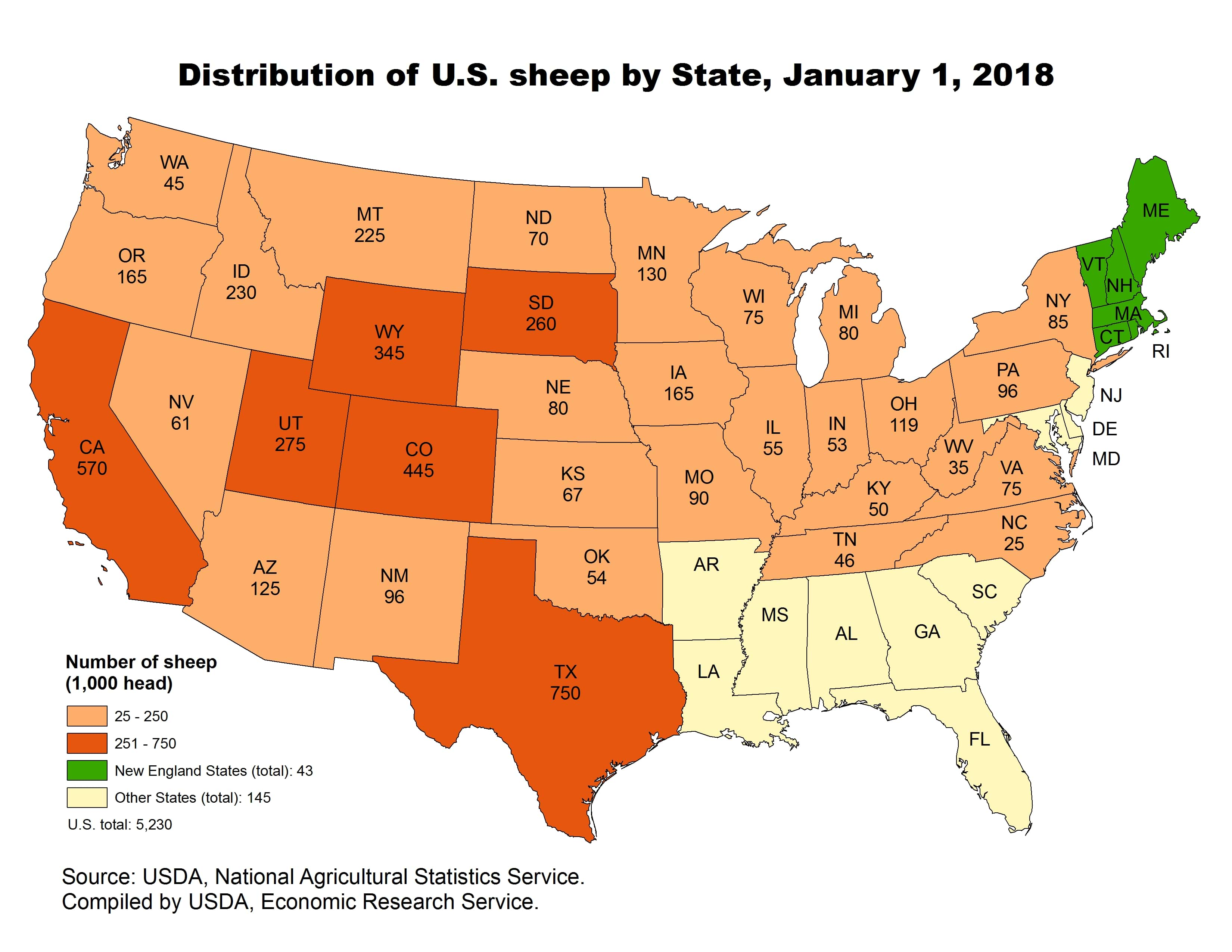
A map of sheep population in the US. Source: USDA (Link)
These populations are the main consumers of sheep and goat meat. The “ethnic consumer” does not actually refer to any particular ethnicity. Rather, it is dependent on populations where lamb and mutton are more frequently consumed as a result of religious, cultural, and practical standards. Some religions restrict the consumption of meat from cows and swine, making sheep and goats the predominant source of meat. Some areas do not have the resources for cow and swine production because of the condition of their geography. Sheep and goats can consume a wider variety of vegetation, especially those found in arid and barren environments that would not support other livestock without excess amounts of supplemental feed. These factors influence the cultural significance of sheep and goat, perpetuating its consumption.
As for fiber production, the demand for sheep fibers has seen a heavy decrease. Ethnic consumers have little effect on fiber demand. Because of this change in demand, the number of sheep raised for wool has decreased. In the case of long-wool breeds, many sellers have shifted to a marketing-based tactic, typically though online means, of directly selling sheep wool. Said wool is commonly used for spinning and yarn production by hobbyists.
Sheep Terminology
Below are some terms used in the sheep industry.
| Term | Definition |
|---|---|
Fine Wool Breed Profiles
Fine wool sheep are the most relevant of the wool-types. Their wool is usually considered the most valuable. Its fine diameter produces softer, more comfortable clothing. These breeds usually have fine, silky hair on their face, ears, and legs. They produce 8-10 pounds of wool per year. Ewes are all polled, rams may be horned or polled.
The advantages of fine wool breeds include: high wool quality and quantity, hardy nature, good ability to adapt to range conditions, longevity, gregarious nature (good flocking instinct), and ability to breed out of season.
The disadvantages of fine wool breeds include: Proneness to wool blindness, body wrinkles, poorly-muscled carcasses, slow growth rate, slow maturity, and a low lambing percentage.
Fine wool breeds include: Rambouillet, Delaine Merino, and Debouillet.
Rambouillet

Forbes, Rabel, and McGivney Rambouillets (Link)
| Quick Facts | |
|---|---|
Rambouillets originated in France. Polled ewes, polled or horned rams. Rambouillets are descended entirely from the Merino. They have pink features and white wool on their body, poll, and legs.

These sheep are the dominant breed in the US, comprising 90-95% of range flocks, of which are the most common management system in the US. Rambouillets are considered the “best” breed of sheep in the US; They are hardy, adaptable, and low maintenance. However, Rambouillets are slow growing, and have low prolificacy.
Rambouillets are the largest of the fine wools. They are bigger and faster growing than Merinos, which makes them better for grain feeding.
Delaine Merino

Milligan's Gander Hill Farm (Link)
| Quick Facts | |
|---|---|
Merinos originated in Spain. Merinos are very similar physically to Rambouillets. Merinos may be wrinkled around the neck and shoulders, though this is uncommon in the US strands of Merino.
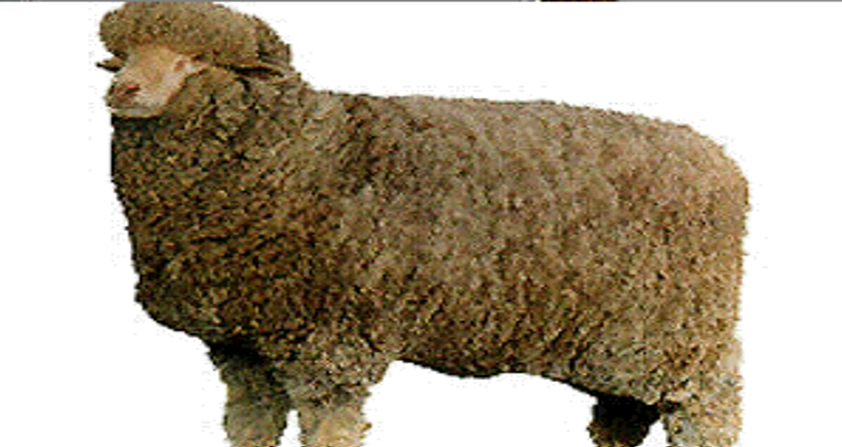
Merinos produce fine, valuable wool with a good staple wight and a heavy grease weight. However, Merinos have poor carcasses. Wool blindness is also an issue. The Delaine Merino is considered the most productive and is well adapted to range conditions in the South and West of the US.
Debouillet
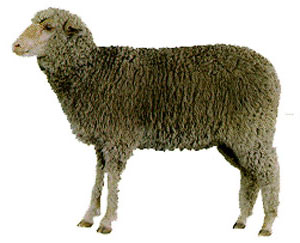
| Quick Facts | |
|---|---|
Debouillets were developed by A.D Jones in Tatum, New Mexico in 1920. They are the result of crossing a Rambouillet and a Merino. Debouillets are white with pink features and wool on the poll and legs.
These sheep are known for their adaptability, gregariousness, and good performance in range conditions. They have a good growth rate and a long staple length.
Long Wool Breed Profiles
These breeds originated in England. They are very limited in numbers in the US. Long wool breeds grow more wool than fine wool breeds, but their wool is coarser and not typically used for clothing. Rather, the wool is used for upholstery and spinning yarn. Long wool breeds typically have dark skin pigmentation and long, coarse wool.
Long wool breeds have many advantages: Their large size is useful in crossbreeding programs, they have heavy, high-yielding fleeces, producing 14-16 pounds of wool per year, typically with a long staple. They also have notable milking abilities.
Long wool breeds also have disadvantages: They have very coarse wool only used in carpets, a low-quality carcass with excessive external fat, and average prolificacy.
Long-wool breeds include: The Lincoln, Cotswold, Leicester, and Romney.
Lincoln

Photographer: John Smith
| Quick Facts | |
|---|---|

Lincolns are distinct in their appearance. They have long, draping wool and a “shaggy” appearance. They are very large, and have the heaviest, longest staple of any sheep. They were developed in Lincolnshire, England, and brought to the US in 1825. Lincoln genetics contributed to American breeds such as the Targhee and Columbia.
Cotswold


| Quick Facts | |
|---|---|
Cotswolds are similar in appearance to the Lincoln. It has important historical significance in England but is not a very popular breed in the US.
Border Leicester
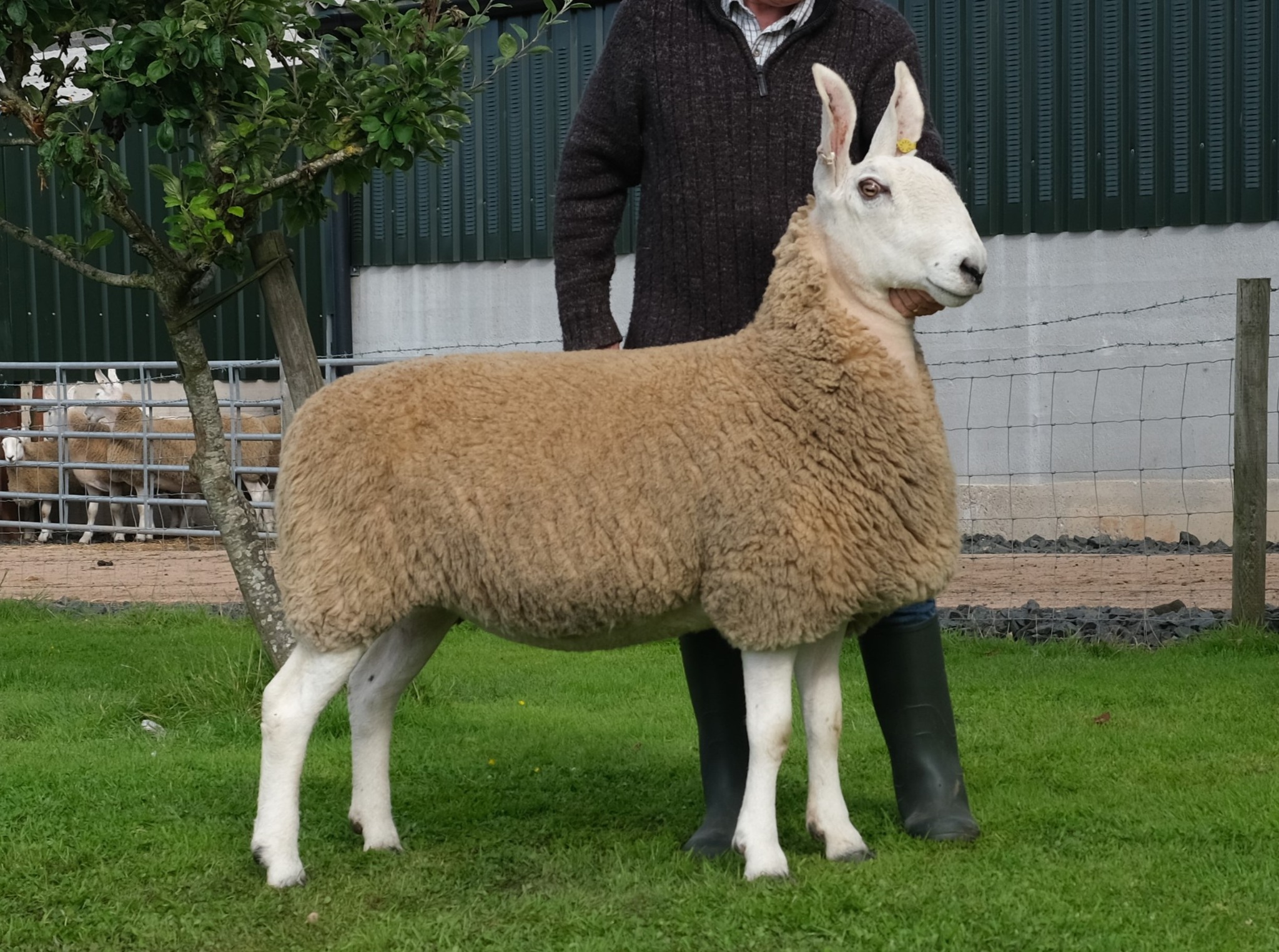
Hayden Border Leicester & Zwartbles Sheep, Facebook (Link)
| Quick Facts | |
|---|---|

Leicesters originated in England. They have upright, bunny-like ears.
Romney
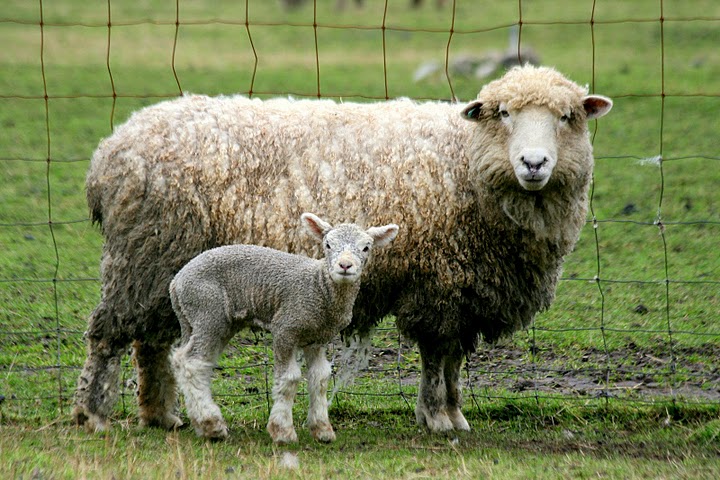
Photographer: Rosemary Washington
| Quick Facts | |
|---|---|
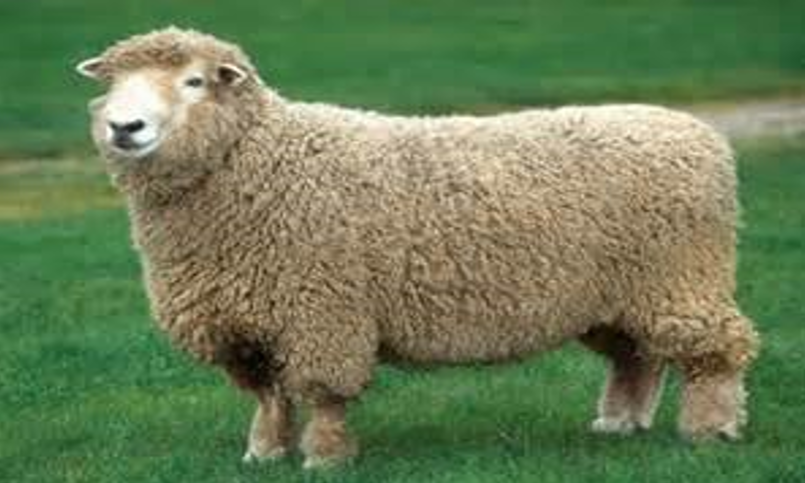
The Romney was developed in England. It has white wool and dark features. Its wool is popular among hand-spinners. The Romney has a unique resistance to foot rot and its wool sheds water well, making it well adapted to rainy, damp environments.
Medium Wool Breed Profiles
Medium wool breeds are produced as a result of crossing long and short wool breeds. They are typically white in color. Rams and ewes are polled.
Medium wool breeds are large in size with heavy fleeces. They are also well adapted to range conditions.
As for disadvantages, their wool is coarser than fine breeds, making it less valuable. They have acceptable carcasses but are not very muscular.
Breeds of medium wool sheep include: The Columbia, Corriedale, Targhee, and Panama.
Columbia

South Dakota State University
| Quick Facts | |
|---|---|
The Columbia was the first breed truly developed in the United States, specifically in Wyoming. This breed was produced from crossing Lincoln rams and Rambouillet ewes. Columbias are polled. They are larger than Rambouillets and have light features.
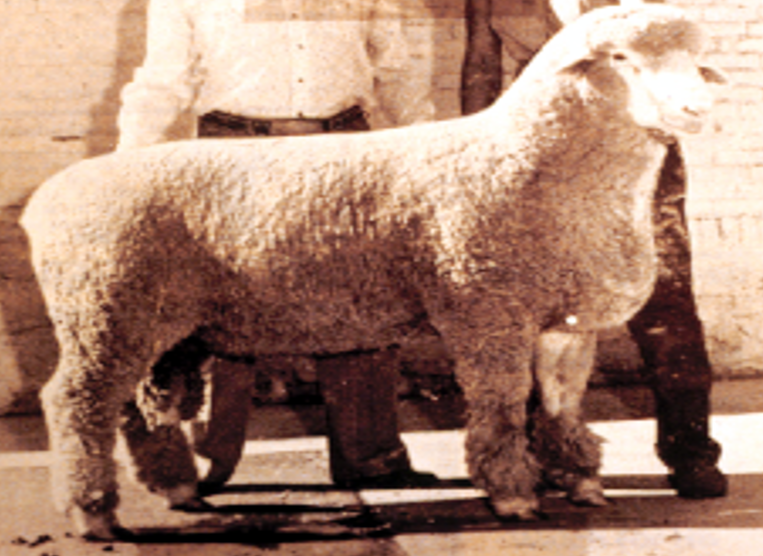
Columbia are adapted to grass-rich regions like Wyoming, Idaho, and the Dakotas. They produce hardy, fast-growing lambs. They are a popular breed, especially for crossbreeding purposes.
Corriedale

Friesz Livestock & Friesz Family Farm, LLC
| Quick Facts | |
|---|---|

The Corriedale originated in New Zealand from crossbreeding Lincoln rams and Merino ewes. They are polled and have dark pigmentation.
Targhee

Skull Creek Targhees
| Quick Facts | |
|---|---|

The Targhee originated from the USDA’s U.S. Sheep Experiment Station in Dubois, Idaho. It was produced as a cross between the Rambouillet, Columbia, and Corriedale. The Targhee has many Rambouillet features. Rams and Ewes are polled. Because of the nature of their origin, the Targhee has many data records associated with the breed, making it much more predictable. The population of Targhees is on the incline. Targhees are popular in the West because of their ¾ fine wool to ¼ long wool breeding ratio.
Panama
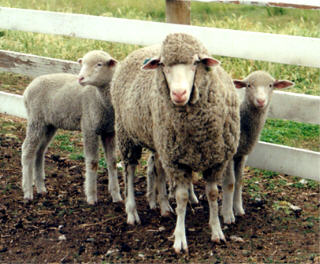
Photographer: Dave Casebolt (University of Idaho)
| Quick Facts | |
|---|---|
The Panama sheep, despite its name, originated in Idaho. It was produced as a crossbreed between Rambouillet rams and Lincoln ewes. The Panama is polled and resembles the Columbia breed. They are medium in size and produce dense, long-stapled wool.
Meat Breed Profiles
Most of the meat breeds originated in England, excluding the Montadale and Texel. Both ewes and rams are polled with the exception of the Dorset – whose rams and ewes may be horned or polled.
The advantages of meat breeds include: Fast growth rate, excellent carcass quality, and high prolificacy.
Disadvantages of meat breeds include: Coarse, light-weight wool, poor flocking instincts, lack of adaptability to range conditions, and a tendency for wool to be contaminated with black fibers.
Meat breeds are better suited as farm flocks than range flocks. Most are black faced with dark features. The Suffolk, Dorset, and Hampshire are the most influential meat breeds. Most breeds of sheep are not genetically consistent. Very few sheep can be considered truly purebred.
Meat breeds include: The Suffolk, Hampshire, Dorset, Oxford, Shropshire, Southdown, Cheviot, Montadale, and Texel.
Suffolk

Roe, Karen. 2013 (Link)
| Quick Facts | |
|---|---|
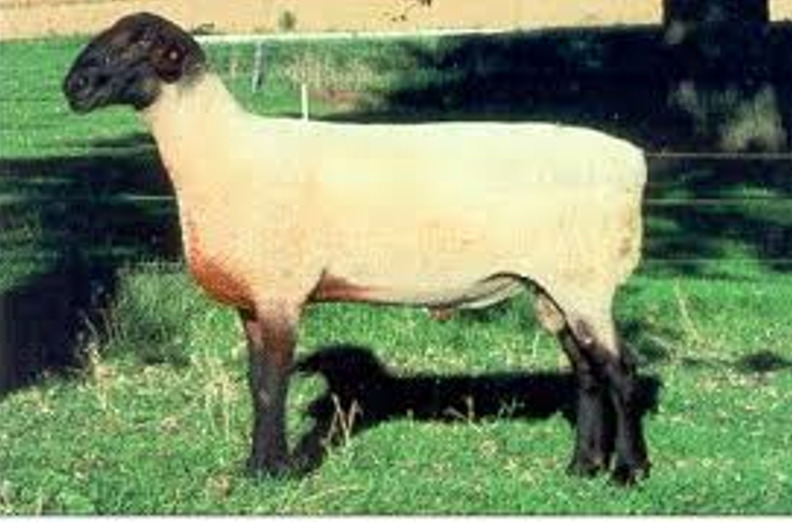
The Suffolk is the largest of the meat breeds. It has a black head and legs, with no wool on the poll and legs.
Historically, the Suffolk were a predominant breed. However, this breed fell in population in the 80’s and 90’s due to its predisposition to genetic disorders. The Suffolk is prone to Spider Lamb Syndrome, a degenerative muscle disorder, as well as Scrapie, a neurological degenerative disorder. Unlike today, these diseases could not be tested for, so the proper means of prevention was to limit the usage of the Suffolk. Today, the Suffolk makes up over half of the population of purebred sheep in the US. Its meat is considered very valuable and is popular among health-conscious consumers.
Hampshire
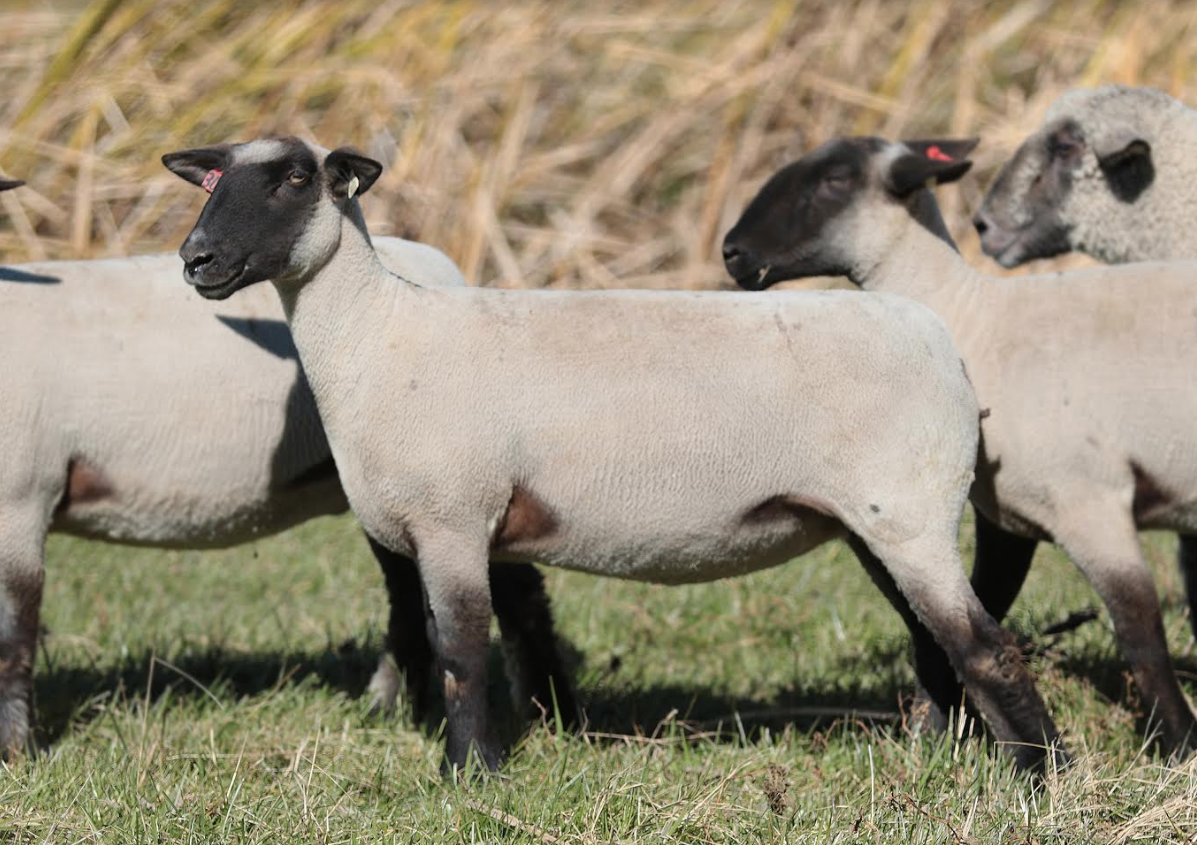
Poe Hamps (Link)
| Quick Facts | |
|---|---|

The Hampshire is similar to the Suffolk. It originated in England. Hampshires have black heads, ears, and legs. It is different from the Suffolk as it has wool on its head and legs.
Dorset
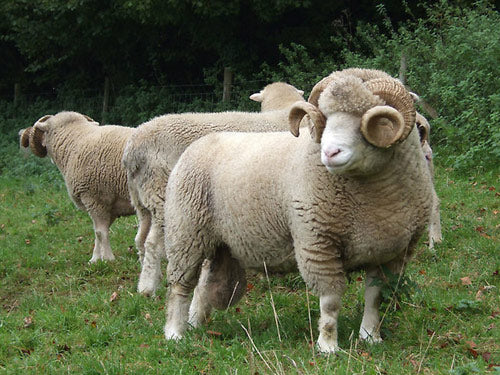
| Quick Facts | |
|---|---|
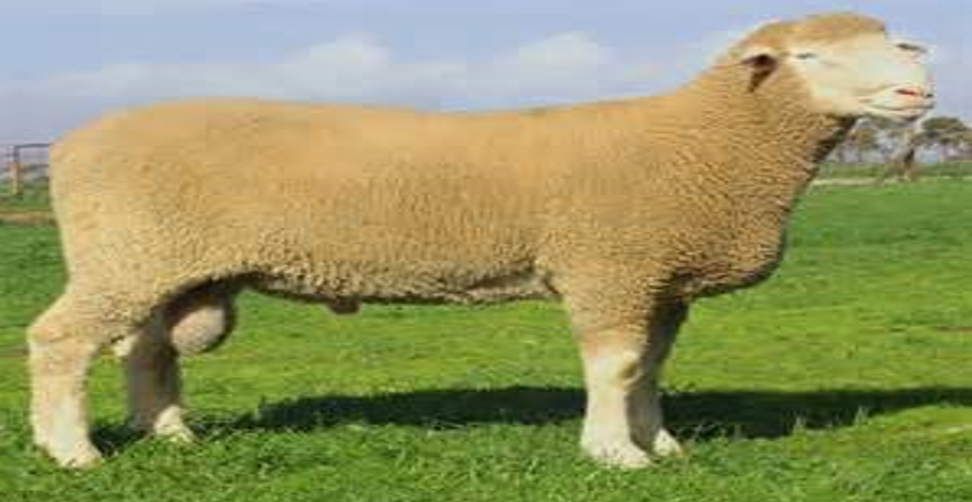
The Dorset is a white-faced breed with pink facial features and wool on its head and legs. Dorset rams and ewes may be horned or polled. One of the star features of the Dorset is its ability to reproduce out of season.
Oxford
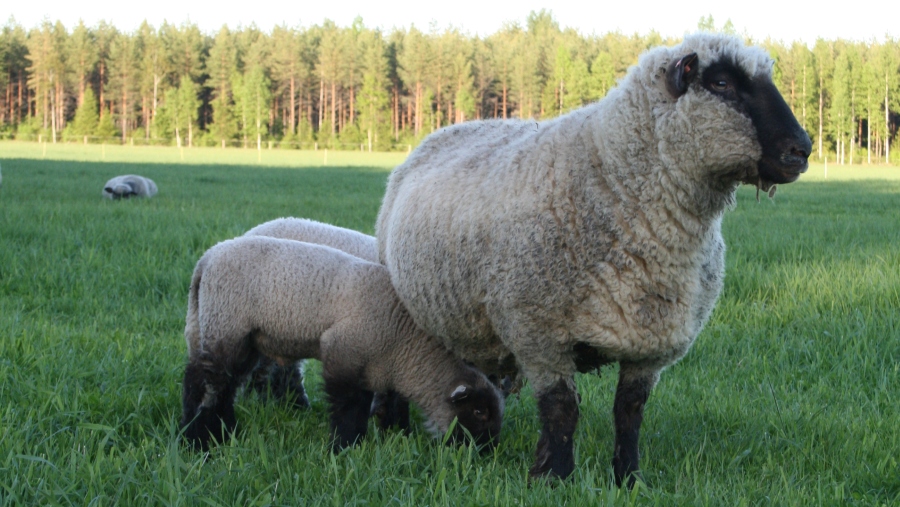
| Quick Facts | |
|---|---|
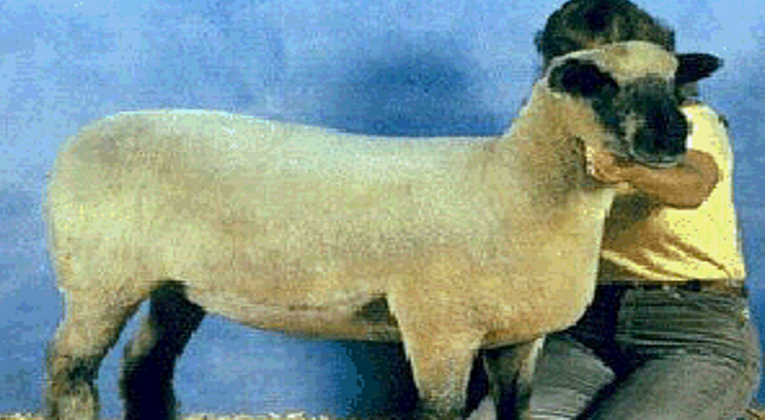
The Oxford originated in England as a cross between Cotswolds and Hampshires. The Oxford has a medium brown to dark grey nose, ears, and feet and wool on its head and legs. This breed is considered minor in the US, only really impacting the area it was developed in.
Shropshire
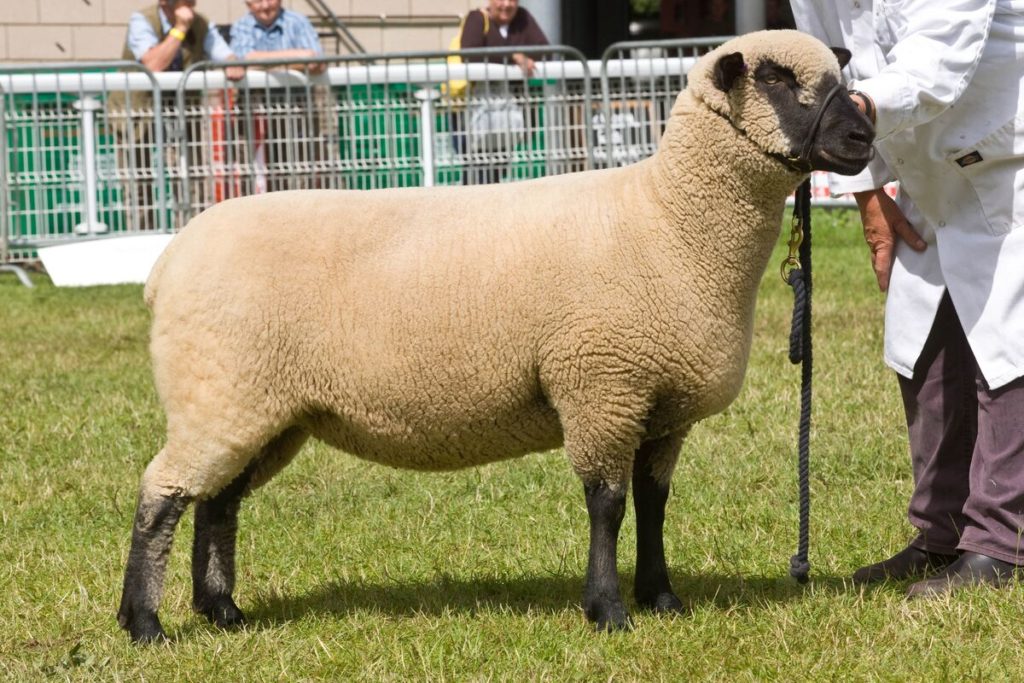
| Quick Facts | |
|---|---|

The Shropshire is similar to the Oxford. It has a dark brown to black head, ears, and legs. It has wool on its head and legs. This breed has Hampshire influence. This breed was very popular in the US until the 1930’s. It is considered a very middle-ground breed, with acceptable performance in many qualities.
Southdown
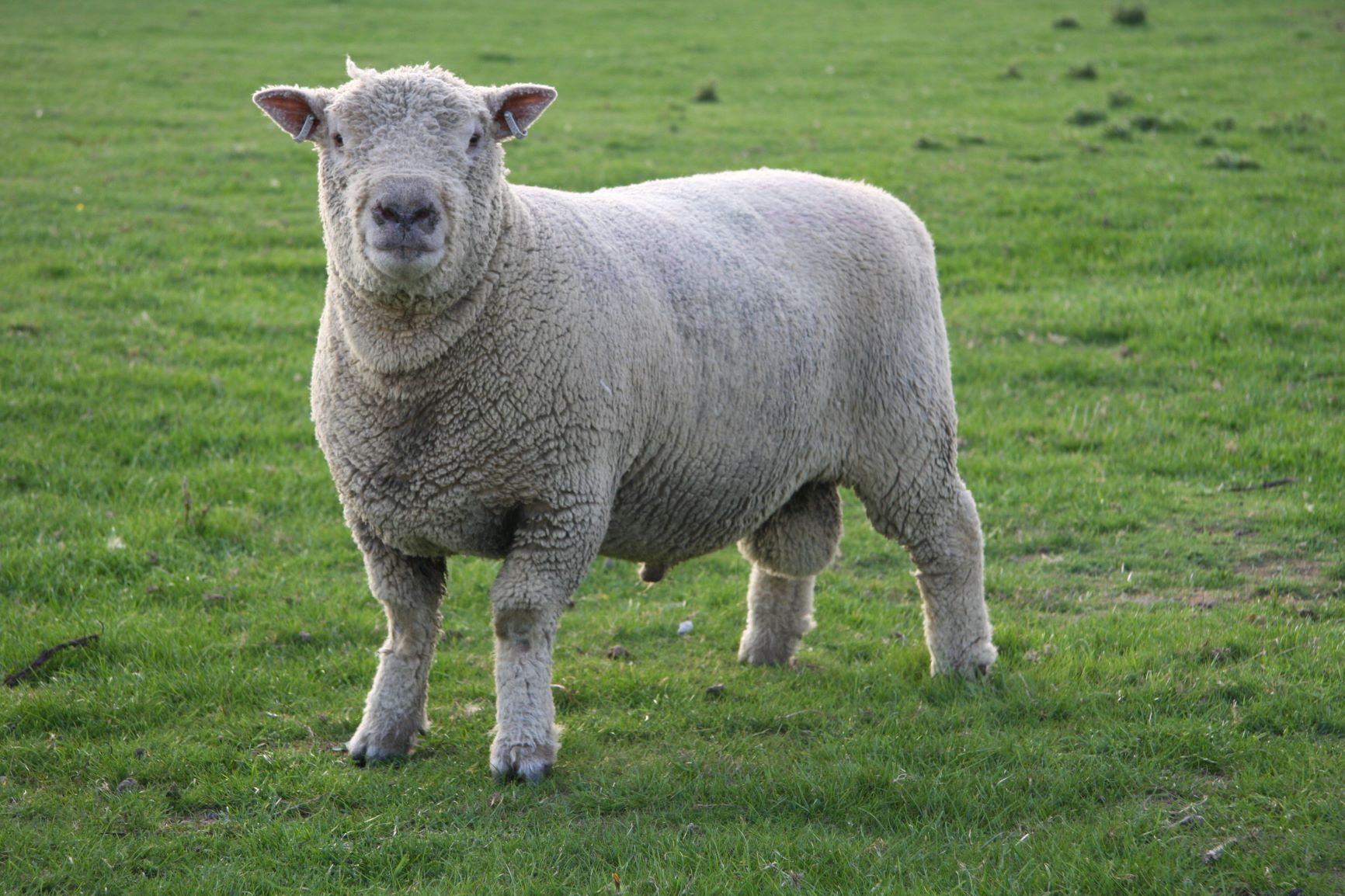
| Quick Facts | |
|---|---|

The Southdown is considered one of the oldest breeds of sheep in the world. Records of development exist as far back as the 15th and 16th centuries. The Southdown is small but muscular, with heavy wool cover all over the body. It is dark gray to light brown in the face, has dark hooves, and small, woolly ears. It is very efficient and fast-growing, with great conformation. Its popularity has varied throughout the years, but it has consistently been used to develop newer breeds. It also looks like a Minecraft sheep.
Cheviot
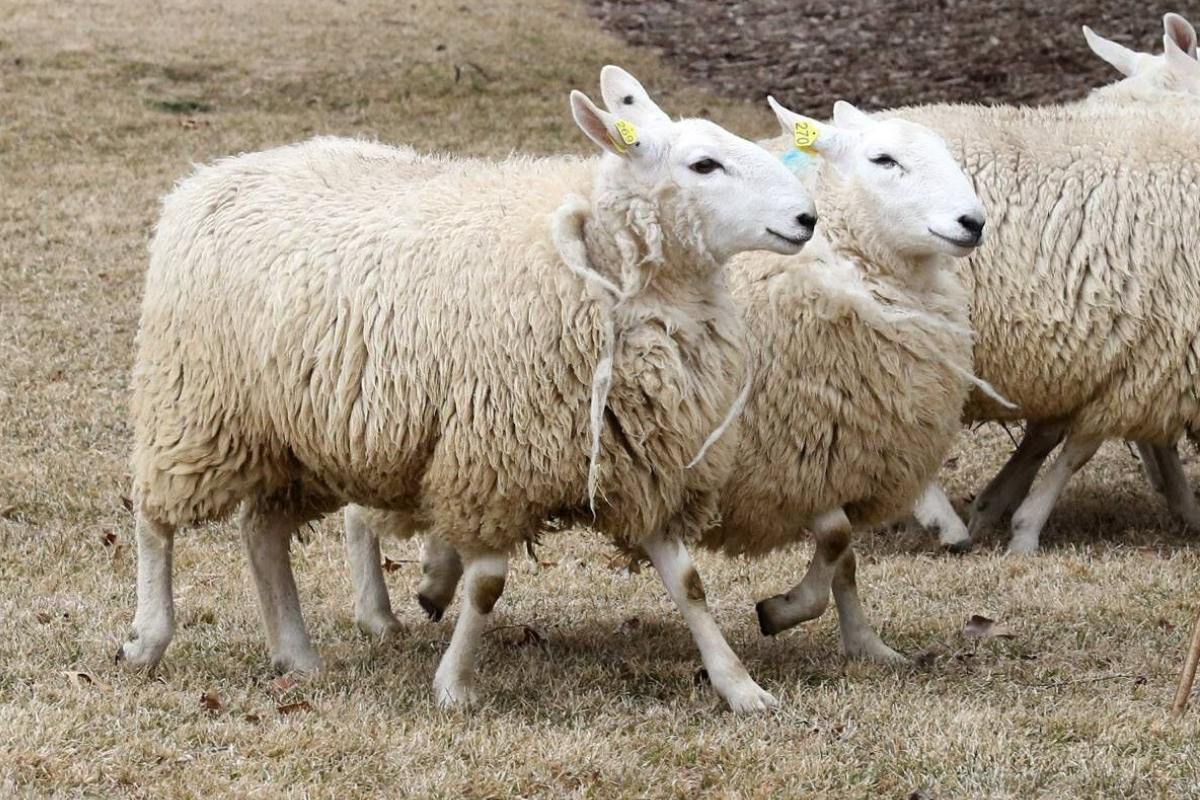
| Quick Facts | |
|---|---|
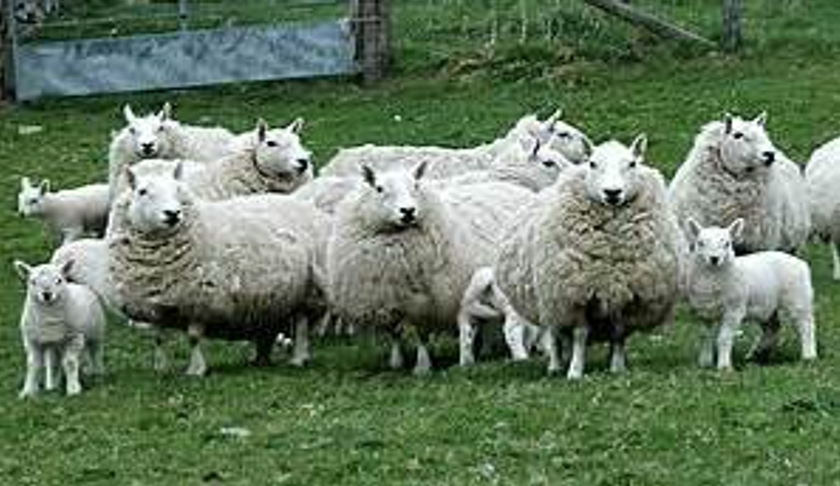
The Cheviot has a white head, erect ears, and black hooves and nostrils. It lacks wool on the head and legs. The Cheviot is similar to the Leicester in appearance. It was developed between England and Scotland. The Cheviot is hardy and independent. Its wool is not particularly valuable but is very durable.
Montadale

Kuykendall (Link)
| Quick Facts | |
|---|---|

The Montadale has a white head, ears, and legs. It is void of wool on the head and legs. The Montadale was developed by E.H. Mattingly in the US from crossing Cheviot rams with Columbia ewes. This breed produces excellent wool and high-quality carcasses. It is popular in the Midwest.
Texel
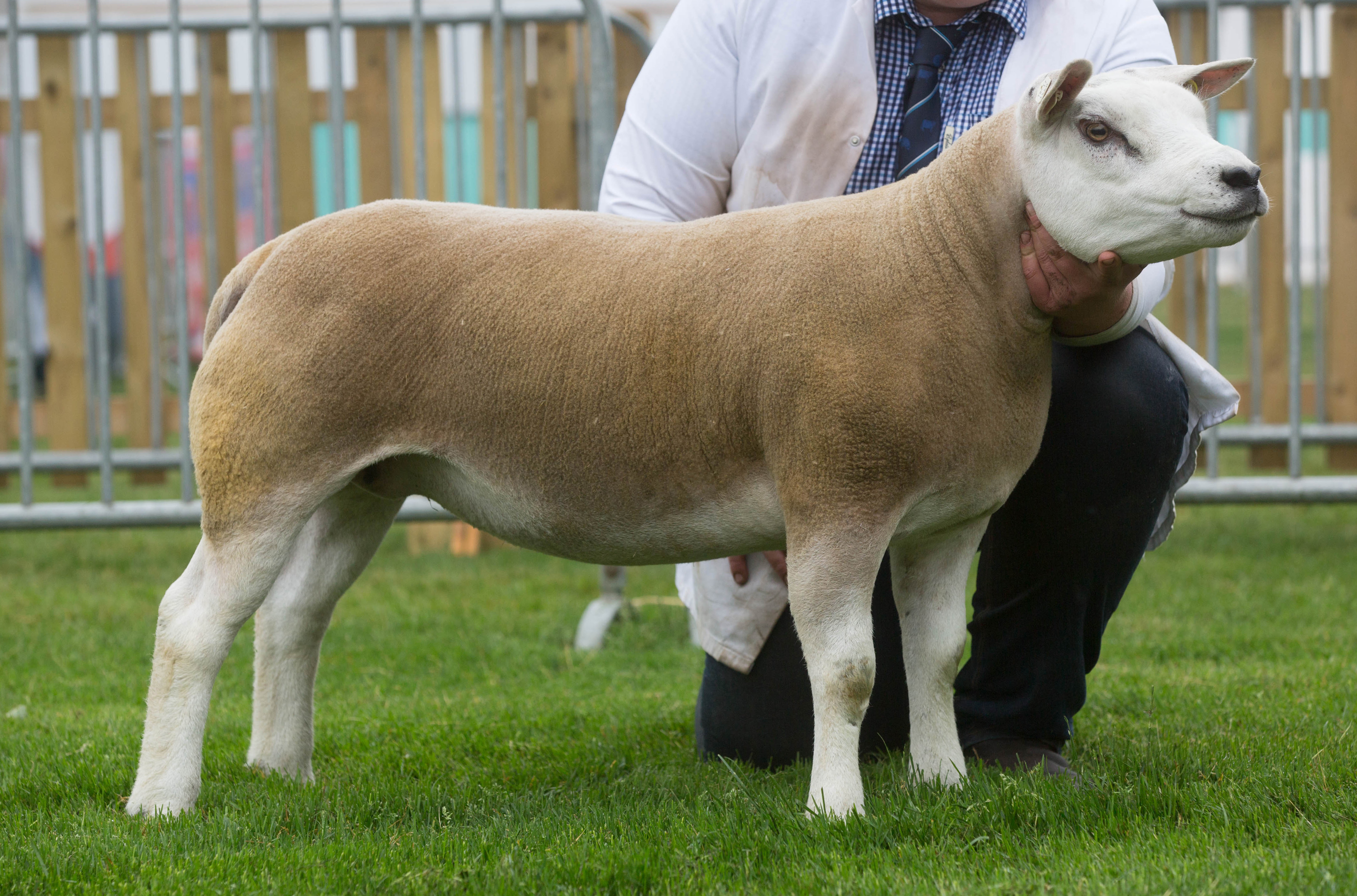
Texel Sheep Society (Link)
| Quick Facts | |
|---|---|
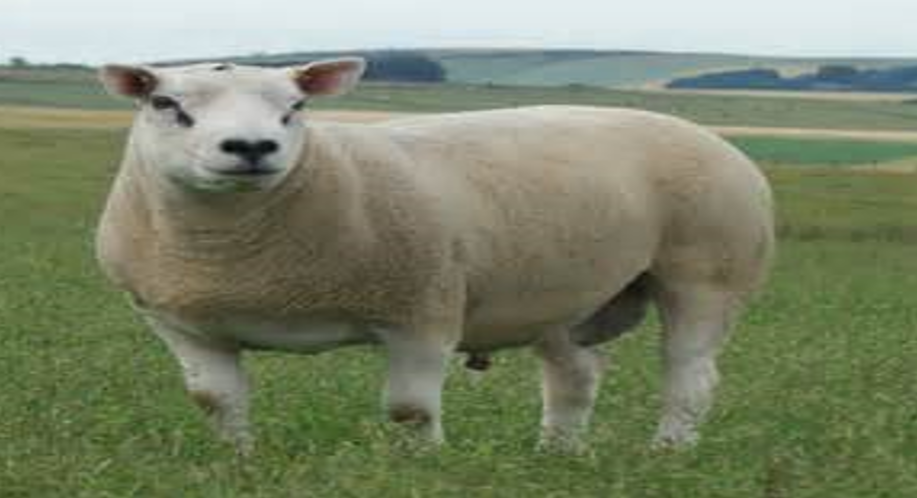
The Texel was developed in Holland (Netherlands). It is a small, compact breed with black features and white wool. There is no wool on the head or legs. This breed is relatively new to the US, being permitted in the 1990’s. This breed has excellent, lean muscling. It is the dominant terminal-sire breed in Europe and increasing in popularity as such in the US.
Reproductive Breed Profiles
These breeds are litter-bearing. They are typically crossbred with breeds that do not produce many lambs.
Reproductive breeds include: The Finnsheep, Polypay, Booroola Merino, and Romanov.
Finnsheep

The Untralight Hiker (Link)
| Quick Facts | |
|---|---|
The Finnsheep is goat-like in appearance, with a white head, ears, and legs lacking in wool. Ewes and rams are polled. The Finnsheep was developed in Finland.
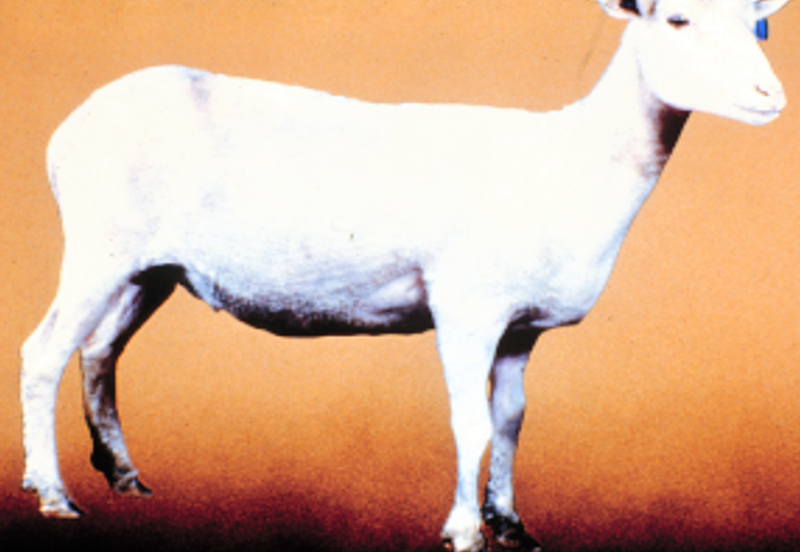
These sheep are incredibly prolific, often averaging 4.5 lambs per ewe, per lambing. They have excellent milking ability and are very maternal. Their tails do not often require docking, as they are born short. These sheep are small, lightly muscled, and have average fleece qualities.
Polypay

American Polypay Sheep Association (Link)
| Quick Facts | |
|---|---|
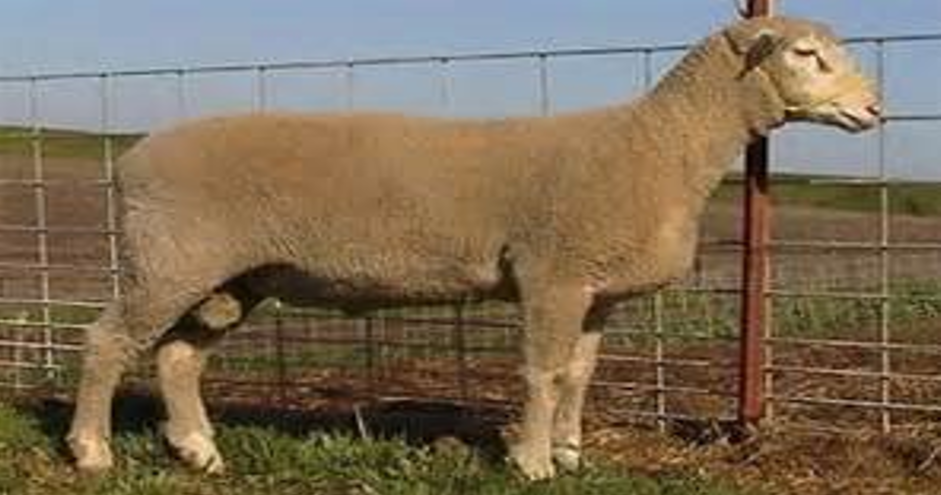
The Polypay is an artificial breed comprised of four foundational breeds. It is developed from the Rambouillet, Dorset, Targhee, and Finnsheep. It is white in color. Ewes and rams are polled. The Polypay exhibits several characteristics of its foundational breeds, such as: High prolificacy, out-of-season breeding ability, hardiness, good flocking ability, and acceptable carcass qualities. It is considered something of a “jack of all trades, master of none.”
Booroola Merino
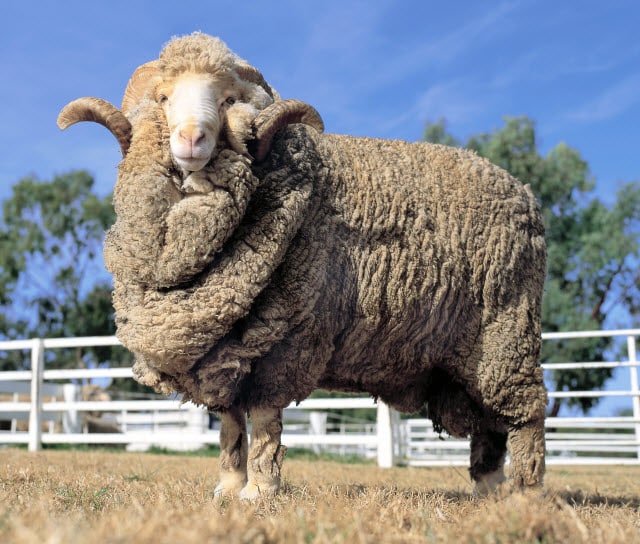
| Quick Facts | |
|---|---|
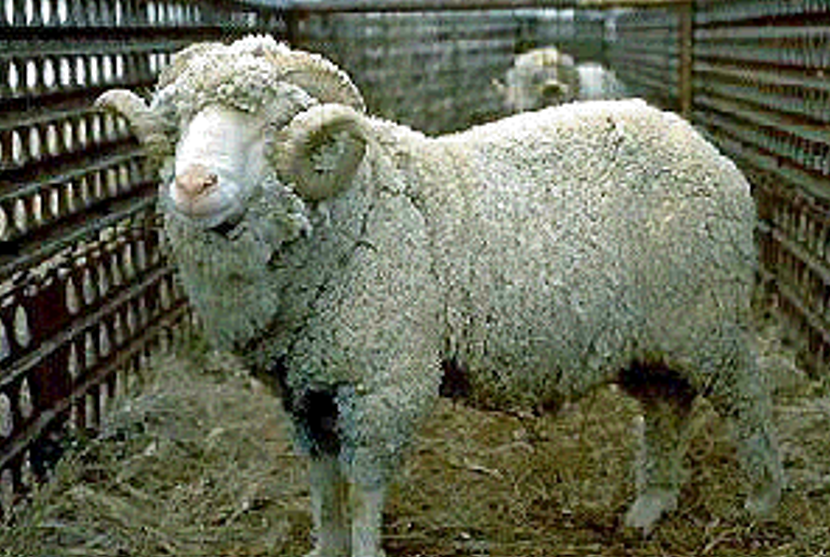
The Booroola originated in New Zealand. Booroolas were developed as a result of a genetic mutation, and thus are prone to issues brought on by inbreeding. They differ from Merinos in that they have an extremely high prolificacy ability and are oftentimes heavily wrinkled. It can produce up to six lambs, has a 20% higher weaning rate, and can breed throughout most of the year.
Romanov

| Quick Facts | |
|---|---|
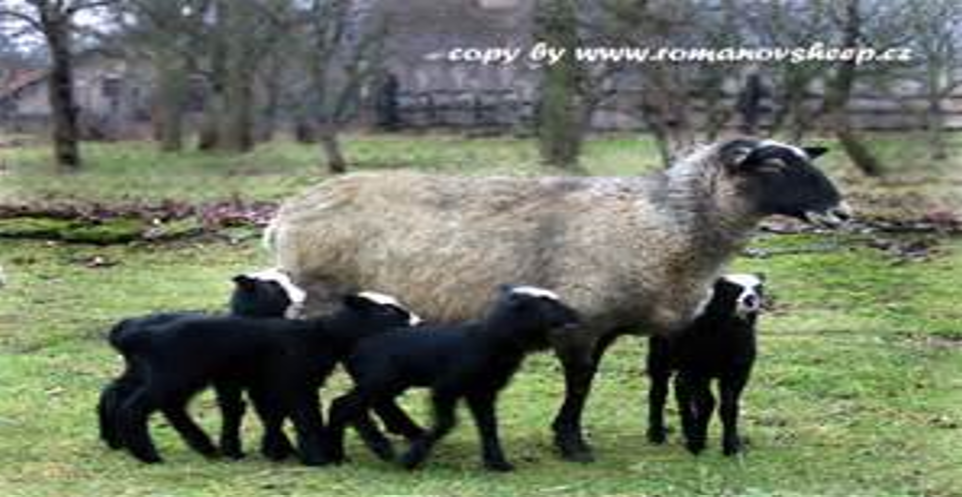
The Romanov originated from Russia, making it a cold-adaptable and durable breed. It has the ability to produce multiple lambs (2-5 per lambing), which are born black in color. This color fades as they grow, but they retain black and grey features that taint the wool. Their wool is used for similar purposes as long-wool breeds, such as in carpets.
Hair/Shedding Breed Profiles
Hair sheep are adapted to hot, humid environments, as they originated in the tropics. These sheep are naturally pests and parasite resistant. They shed their wool seasonally. These sheep are hardy, reach puberty at a young age, and are very proliferate. They’re good under range conditions and can breed out of season. They are well-suited to the needs of ethnic consumers. However, they have low growth rates and small, lightly muscled carcasses.
Hair sheep breeds include: The Karakul, Dorset, Persian Blackhead, St. Croix, Royal White, Katahdin, Barbados Blackbelly & American Blackberry, Pelibuey, and Texas Dahl.Karakul
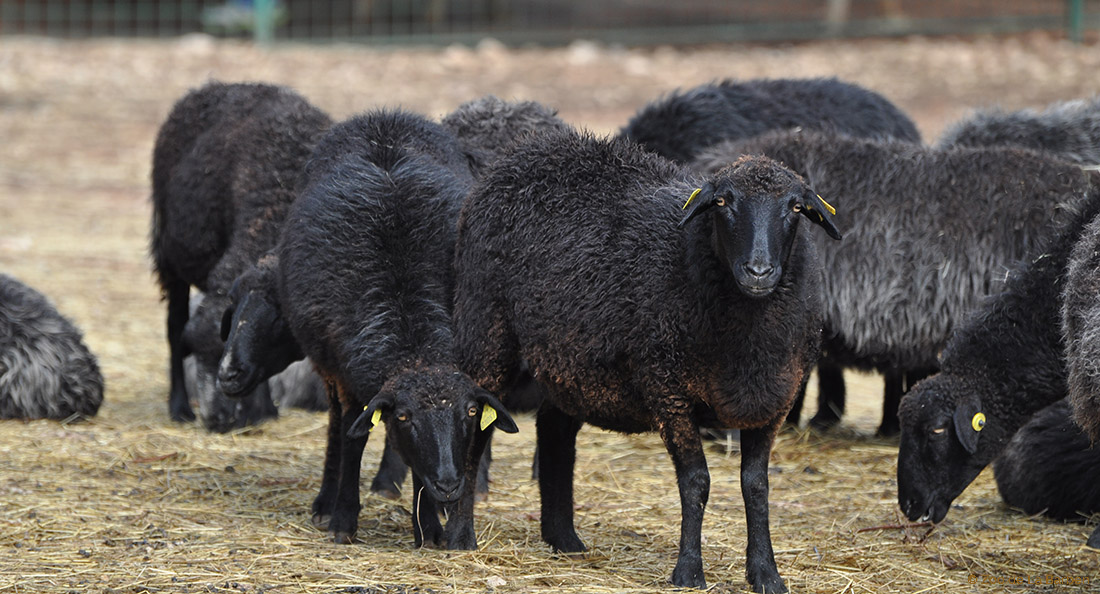
| Quick Facts | |
|---|---|
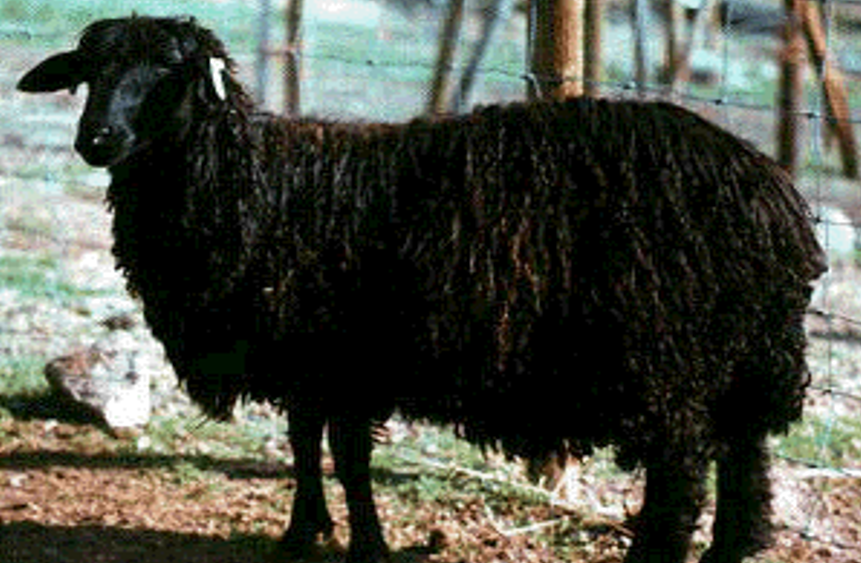
Karakul are considered the oldest domesticated breed of sheep in the world. They developed in Persia and Central Asia. The hides or Karakul lambs are used to make Persian rugs. Karakul are genetically distinct from western sheep, being a breed of fat-tailed sheep. The fat in their tails is used to store energy.
Dorper
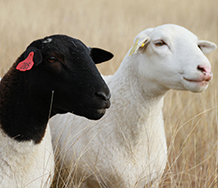
| Quick Facts | |
|---|---|

The Dorper is the only breed of shedding sheep relevant in the US. It originated in South Africa where it is one of the most popular breeds. The Dorper is a result of crossing Dorset with the native Persian Blackbelly. Dopers are originally white with a black head, but a strain of purely white Dorset exists. It is the most muscular of shedding sheep, and the most expensive. It is durable with good reproduction but is prone to parasites. They have a mixture of hair and wool, which will shed seasonally.
Persian Blackhead

Coolibah Persian Sheep Stud (Link)
| Quick Facts | |
|---|---|
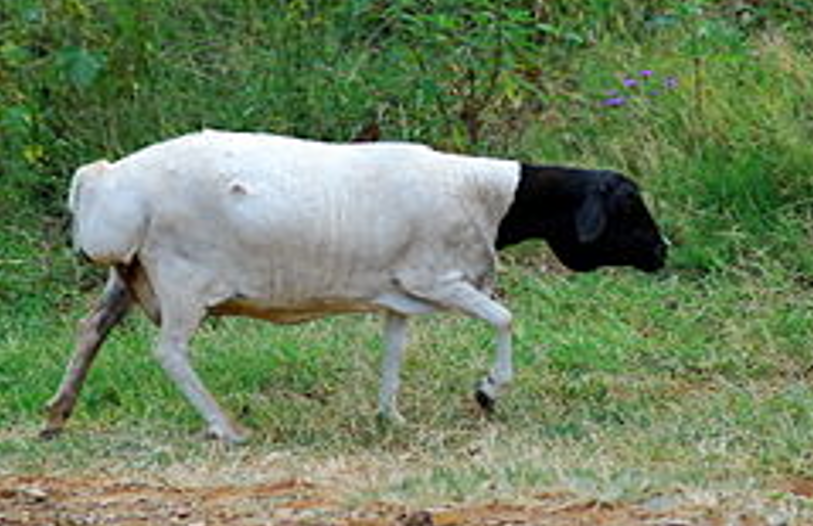
The Persian Blackhead is a breed of fat-tailed sheep native to South Africa. When crossbred, this sheep affects fat deposits.
True Hair Sheep
St. Croix

| Quick Facts | |
|---|---|
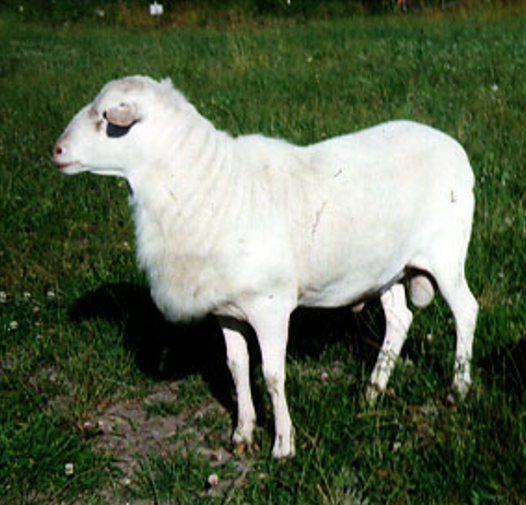
The St. Croix is a hair sheep breed developed in the Virgin Islands. It is an all-white sheep that is polled in both rams and ewes. Rams have a large neck ruff. The breed is exceptionally resistant to parasites and has good prolificacy.
Royal White

| Quick Facts | |
|---|---|
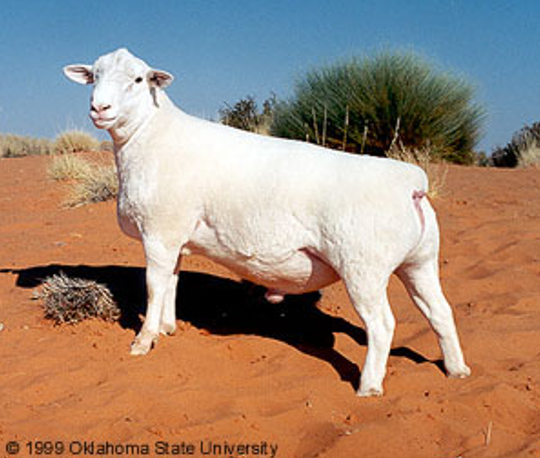
The Royal White is a cross between a Dorper and a St. Croix developed in Hermeleigh, Texas. Rams and ewes are polled. They are a useful white breed that is moderate in size.
Katahdin
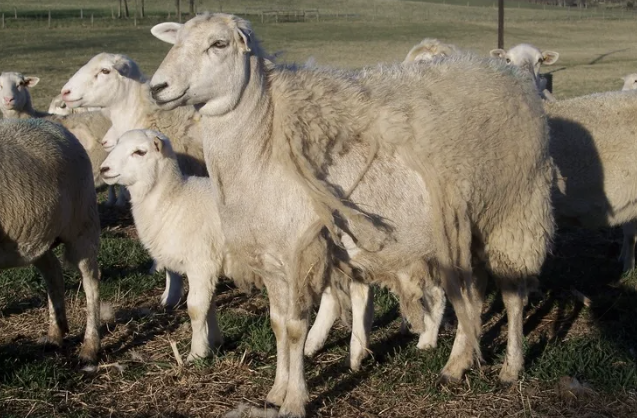
| Quick Facts | |
|---|---|
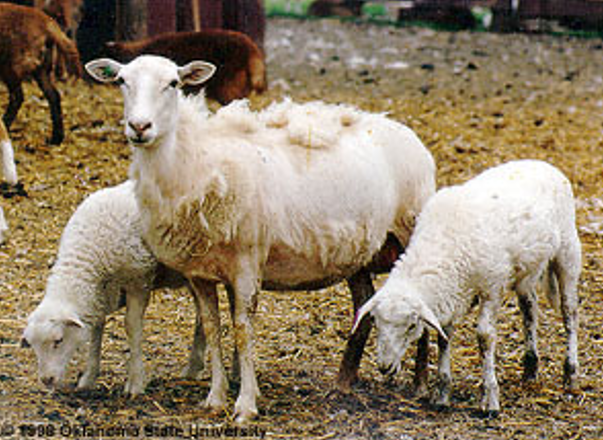
The Katahdin was developed in Maine from crossing Caribbean hair sheep with Wiltshire Horns and shedding Suffolk sheep. It is one of the most popular breeds of purebred sheep in the US due to its excellent parasite resistance and great carcass qualities. They are mostly white and are typically polled.
Barbados Blackbelly & American Blackberry
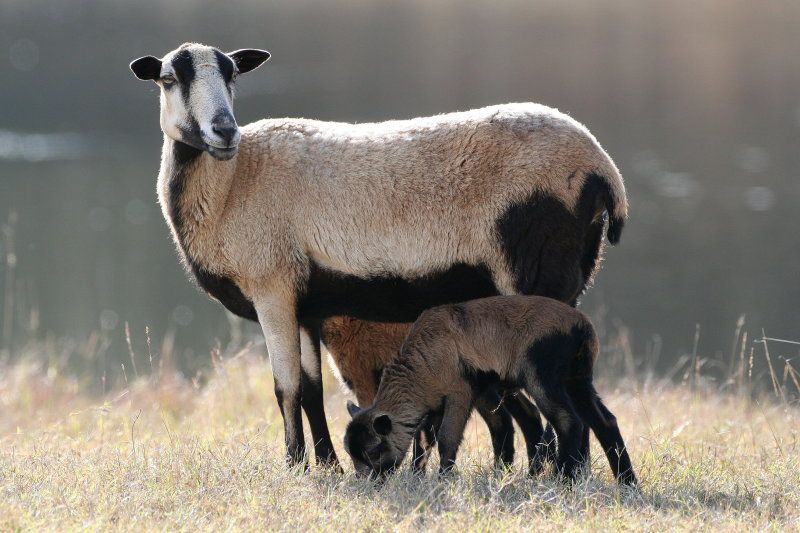
| Quick Facts | |
|---|---|
American Blackbelly originated in Texas, USA |
|

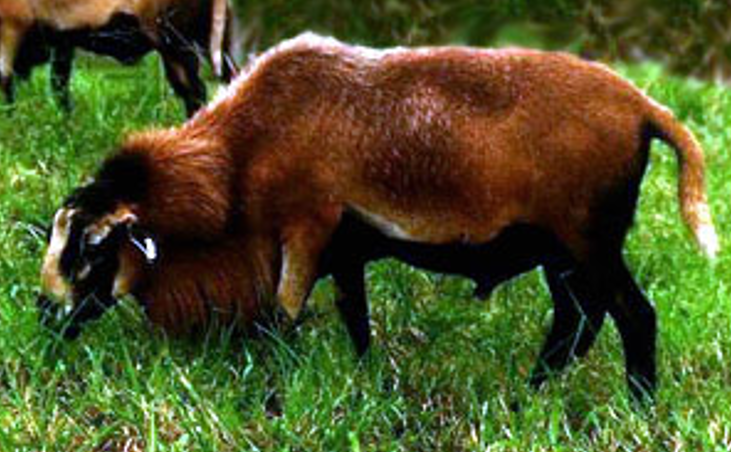
The Barbados Blackbelly originated in Barbados. They are brown with black points. It is one of the original hair breeds in the US. True Blackbelly sheep are polled, with a horned equivalent called the American Blackbelly or Barbados sheep being developed in the US for hunting purposes from crossbreeding with Rambouillet and Mouflon sheep. These sheep are poor in muscling but are very hard to range conditions. They are also extremely prolific.
American Blackbelly (top) &
Barbados Blackbelly (bottom)
Pelibuey

Susan S. 2007 (Link)
| Quick Facts | |
|---|---|
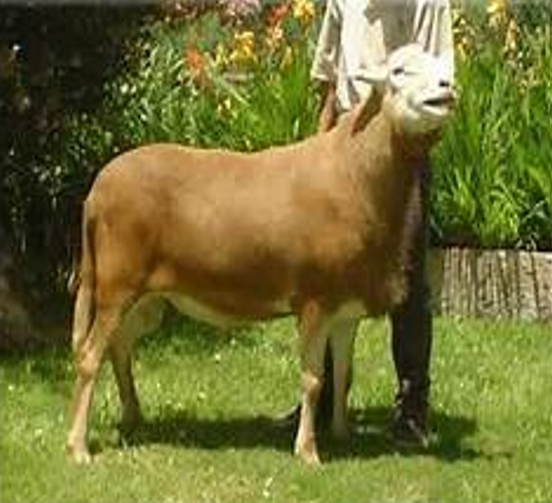
The Pelibuey is a popular breed of hair sheep in South America. It comes in a wide variety of colors, and is typically polled, but can be horned.
Texas Dahl
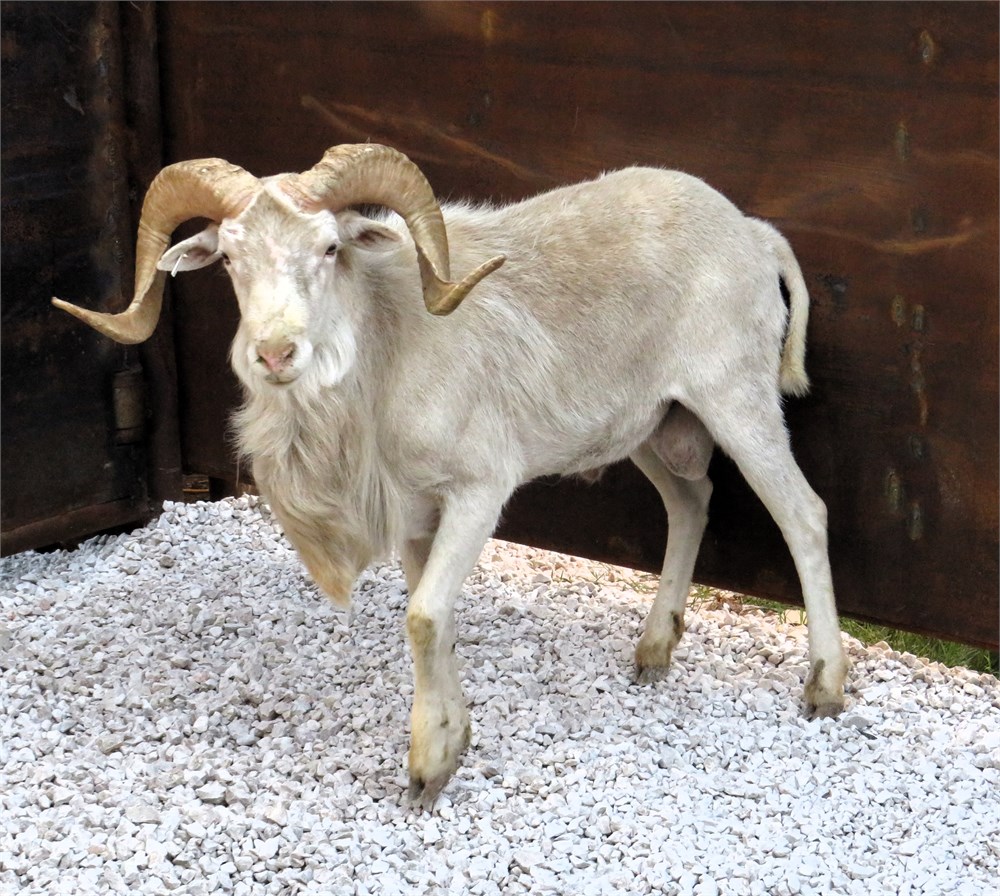
| Quick Facts | |
|---|---|
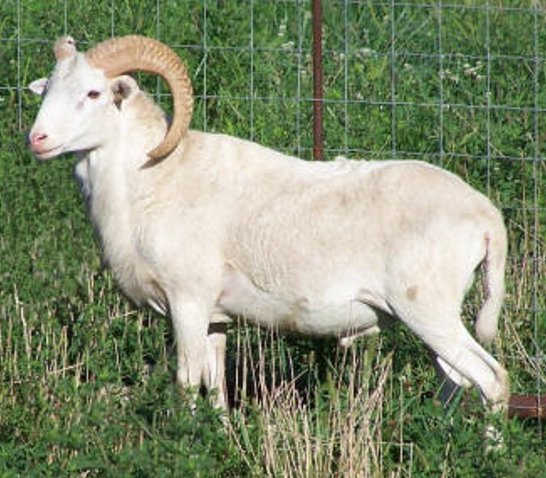
The Texas Dahl is a cross between Rambouillets and Barbados sheep with Mouflon sheep. Most are white, but they can range to champagne in color. They are primarily used for trophy hunting, as they have large, excellent horns.